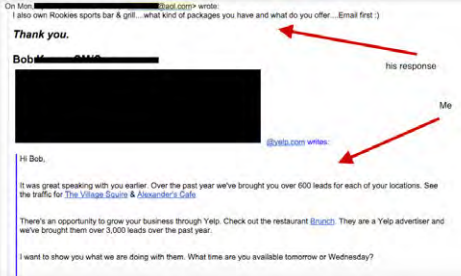9.9: Case study - Yelp
- Page ID
- 36780
One-line summary
A Yelp salesperson tripled her B2B email marketing response rate by personalising and humanising email copy.
The challenge
Yelp’s sales email templates were dry and unengaging, not considering the audience to whom they were writing and included no consideration of features vs. benefits. This caused a disconnect between the brand and its audience. The emails made the salesforce sound, “Like a bunch of robots… with no personality” (Medhora, 2015)
The solution
One Yelp salesperson tested a number of more personalised emails and came up with a formula that increased response rates considerably. She focused on showing that she was a real person and on building a sense of urgency, and her formula looked like this:
Feature + Benefit + Value + Human Factor = Email more likely to earn a response
So, for example, for the feature, she would link to a business’s Yelp pages. The benefit would be a description of how the business can grow through Yelp. The value would be indicating how many leads the business had found through Yelp, and the human factor involved casual subject lines and use of emojis. The subject line for the email below was “Re: Yelp Email Per Your Request – A Response Would Be Appreciated☺.

The salesperson ran a few experiments to measure the success rates of personalised emails against Yelp template emails, added some important factors to consider – how the copy attracted attention, ignited interest and desire, and encouraged action – and then made sure that the email was interesting as well. She also tested a number of headlines, or subject lines, to see which had the best response rates.
The results
- Her response rate rose from 3.33% to 11.43% (even if some of the responses were negative!)
- She learned some important lessons about how personalising your copy, thinking about features vs. benefits, and writing for an audience of one can improve responses!


